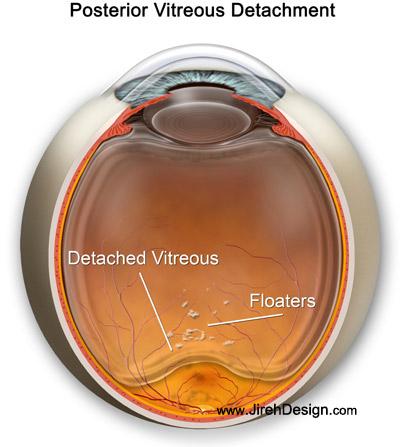Vitreous detachment
What is a vitreous detachment? Most of the eye’s interior is filled with vitreous, a gel-like substance that helps the […]


Vitreous detachment
What is a vitreous detachment? Most of the eye’s interior is filled with vitreous, a gel-like substance that helps the […]
What is a vitreous detachment?

In most cases, a vitreous detachment is not sight-threatening and requires no treatment.
A vitreous detachment is a common condition that usually affects people over age 50
As the vitreous shrinks, it becomes somewhat stringy, and the strands can cast tiny shadows on the retina that you may notice as floaters, which appear as little “cobwebs” or specks that seem to float about in your field of vision. If you try to look at these shadows they appear to quickly dart out of the way.
In addition to cobwebs, another symptom of a vitreous detachment is a small but sudden increase in the number of new floaters. This increase in floaters may be accompanied by flashes of light (lightning streaks) in your peripheral, or side, vision. In most cases, either you will not notice a vitreous detachment, or you will find it merely annoying because of the increase in floaters.
PVD is a common condition that usually affects people over age 50, and is very common after age 80. People who are nearsighted are also at increased risk of PVD. Those who have a vitreous detachment in one eye are likely to have one in the other, although it may not happen until years later.
Is a vitreous detachment dangerous?
Although a vitreous detachment does not threaten sight, once in a while some of the vitreous fibers pull so hard on the retina that they create a macular hole or lead to a retinal detachment. Both of these conditions are sight-threatening and should be treated immediately. If left untreated, a macular hole or detached retina can lead to permanent vision loss in the affected eye.
Those who experience a sudden increase in floaters or an increase in flashes of light in peripheral vision should have an eye care professional examine their eyes as soon as possible. The only way to diagnose the cause of the problem is by a comprehensive dilated eye examination. If the vitreous detachment has led to a macular hole or detached retina, early treatment can help prevent loss of vision.
Watch a vitreous detachment animation
Ref: National Eye Institute






